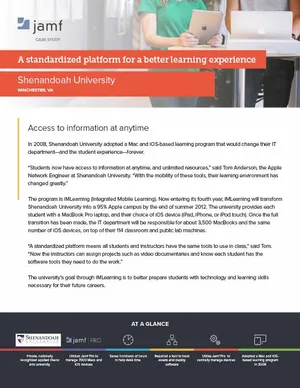In 2008, Shenandoah University adopted a Mac and iOS-based learning program that would change their IT department—and the student experience—forever.
“Students now have access to information at anytime, and unlimited resources,” said Tom Anderson, the Apple Network Engineer at Shenandoah University. “With the mobility of these tools, their learning environment has changed greatly.”
The program is iMLearning (Integrated Mobile Learning). Now entering its fourth year, iMLearning will transform Shenandoah University into a 95% Apple campus by the end of summer 2012. The university provides each student with a MacBook Pro laptop, and their choice of iOS device (iPad, iPhone, or iPod touch). Once the full transition has been made, the IT department will be responsible for about 3,500 MacBooks and the same number of iOS devices, on top of their 114 classroom and public lab machines.
“A standardized platform means all students and instructors have the same tools to use in class,” said Tom. “Now the instructors can assign projects such as video documentaries and know each student has the software tools they need to do the work.”
The university’s goal through iMLearning is to better prepare students with technology and learning skills necessary for their future careers.
So, what was the problem?
From an outside perspective, the iMLearning program may have seemed like an effortless operation. But, like many great success stories, not everything was perfect right from the get-go, and there has been substantial effort put forth in the background. As the university transitioned to this new platform, their IT department soon found their system for keeping tabs on each end-user machine was less than ideal.
“We only had basic information in our asset system. We knew the serial number and who owned it...but once it got issued to the end user it kind of went into a dark hole,” said Tom. “Because of that, we didn’t have enough information to get very proactive.”
Not only was collecting inventory a challenge for Tom’s team, imaging was often a time sink and scheduling nightmare. With a monolithic imaging approach—and a contracted third-party vendor they were only able to work with once a year—adding on to the image after the machines were in the hands of end users required hours of additional manual work (involving both tech support and the end user). Lab and classroom imaging was equally exasperating since coordinating imaging projects with class schedules often involved either class disruption, or tech support working night and weekend shifts.
While the information they had was better than nothing, as an IT administrator responsible for thousands of valuable assets, maintaining a system without full visibility was no doubt discomforting.
“If new hardware or software came out, it was go back to the drawing board...do it all over again,” said Tom. “There was a lot of pain if something came up a week after you had certified the image and it had already been shipped to the vendor.”
Eventually, it came to a point where Tom’s team had no choice but to seek help. They had a number of management solutions in mind, but as a campus that was soon to be nearly 100% Apple, the clear choice was the best-of-breed Apple management solution: Jamf Pro.
Change is in all things sweet
“It really has changed everything for us.”
It’s been a little over one year since Shenandoah University has been using Jamf Pro in their environment. While Tom said he feels like they’ve only laid the groundwork, the impact has already made their lives significantly easier. The workload for routine tasks has been eased and the Help Desk employees can unleash their valuable skillsets on other projects. Not to mention, they have a newfound confidence to confront any type of IT crisis.
“Now we know if there is something crucial that does pop up, it’s not something we need to fear,” said Tom. “We’re in a much better position to manage everything we have. It’s a peace-of-mind thing.”
Self-sufficiency via Self Service
A tool within Jamf Pro that has brought relief to Tom’s team is Self Service. Previously, when an end user needed software installed, they had to take time to visit the Help Desk for assistance with the installation. Now, the software is available for them on-demand, at any hour of the day or night. All applications are configured beforehand, requiring little end-user interaction with the installation. From October 2011 to May 2012 there have been nearly 2,800 Self Service installations that have required little to no IT interaction.
Based on that information, Tom calculated that as of the end of May the Help Desk has been able to reclaim 300 hours of staff time that would have been spent installing software. At eight hours a day, that’s just less than 38 days that can be devoted to projects they were unable to complete without Jamf Pro.
“It’s lightened the load enough that one of the Help Desk guys works with me once a week on the engineering side,” said Tom. “We’ve been able to leverage this tool to free up his workload, and now he’s doing more valuable work than just installing software.”
Additionally, Jamf Pro has assisted with urgent patch management needs, upgrade policies with minimal end-user disruptions, temporary account creation for the university’s loaner computer system, and countless other time-consuming tasks that are now automated.
And even the students have noticed a difference. According to one student’s feedback, Self Service has been a wonderful time saver.
“I’ve found the Self Service application to be incredibly helpful to me as a student. Whenever new software is available that I may need for class, I can download and install it whenever I have a few minutes. It’s great not having to make a separate trip out of my way to visit the Help Desk office in person! I do a better job of maintaining my own computer because I don’t have to deal with an extra appointment on top of my busy schedule.”

